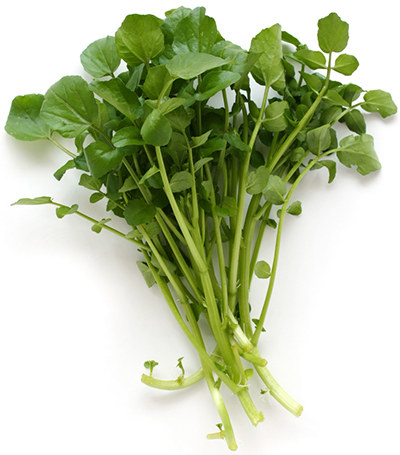Nasturtium officinale
Watercress is a perennial plant of the mustard family (Brassicaceae), native to Eurasia and naturalised throughout the world in cool flowing streams where it grows submerged, floating on the water, or spread over mud surfaces. It has now naturalised itself in New Zealand. Watercress often is cultivated in tanks for its young shoots, which are used in salads. The plant bears four petalled, white flowers and delicate, light green, peppery – flavoured leaves rich in ascorbic acid (Vitamin C). Seed pods are small and bean-like, with two rows of seeds.
Although an aquatic perennial which likes to grow with its roots in mud, or under water, it can be cultivated in rich moist garden soil, with frequent watering, but the pungency then increases. It is easily propagated by stem or root cuttings taken at any time and rooted in water. Alternatively, seeds may be sown in a prepared box. When seedlings are large enough to handle, transfer to a trough half filled with loamy soil, and place in semi shade. As the seedlings grow, gradually fill the trough with water, gradually tipping away carefully about once a week and refilling with fresh water. The more cress is cut the more it will branch, and prevents flowering.
Watercress is so common in some countries that its valuable medicinal and dietetic values are often forgotten, even though for centuries it was an official medicine.
Because of pollution, it is not wise to pick from streams that run though sheep country, as watercress is host to sheep’s liver fluke.
Cress is rich in Vitamins A, B2, C, D, E, and minerals, including manganese, iron, phosphorus, iodine and calcium. It is a natural blood purifier, and it is said to clear the complexion and brighten the eyes. In some communities in Western Europe, cress has been taken as an oral contraceptive and abortifacient, while in the Philippines it was regarded as an aphrodisiac. Less exciting uses in other countries have been in treating coughs, head colds, asthma and tuberculosis. If taken regularly in the form of tea, soup, or raw in salads, cress clears the complexion, brings back a sparkle to the eyes, and helps prevent hair from falling out.
Watercress can be eaten raw in salads or sandwiches, or used in a soup. It can be cooked like spinach, puréed, and even used in a quiche. It makes excellent sauces for chicken, veal and fish. If cooked as a vegetable, it takes two changes of water to eliminate the bitterness. Both land and watercress can be used in herb butters. A favourite combination is homemade wholemeal bread, watercress, and a bottle of Guiness. Watercress is best eaten before, or just as, it comes into flower.
American Upland Cress (Barbarea praecoz) grows to a full rosette of dark green jagged leaves up to 6 inches long, with a typically hot flavour. However it does not survive a hot summer.
French Cress has pale green leaves, quite undivided, but with a frilled edge, and resembles young lettuce. Although it bears no resemblance to the other cresses, once again the flavor of the leaves is pepper hot.
Lebanese Cress is indigenous to Europe & West Africa. It is an easy-to-grow perennial ground cover. Soft fern-like sprawler, easily exhausted if confined. Cut often to stop it going to seed. It flowers in terminal clusters in perfect conditions. Propagation is easiest by root division. Grows in shade, in full sun if sufficient water, and can spread rapidly, similar to mint. It is used as a salad herb, garnish, in tossed salads, coleslaw, stir-fry (add at the last minute), flavouring for carrots, in vegetable juices, and as a lettuce substitute.
Land cress (Barbarea verna) is a biennial which will grow in any average garden. If it doesn’t get enough water it goes to seed. It grows in the shape of a rosette. The lower leaves reach up to 15cm in length with a large lobe at the end, and one to four pairs of smaller lobes along both sides of the stalks. They are a bright green colour. There is also a variegated form with creamy-yellow markings on the leaves. During the second year, a tall flower stem with smaller leaves growing rises from the rosette. It is branched, and produces many bright yellow flowers which are followed by pale fawn seed pods which scatter seeds everywhere as they ripen. Pleasant peppery flavour used in salads and as a vegetable. Land cress can be used in herb butter.
References:
Potpourri Vol. 10 No 3 April 1987 Hemphill, Rosemary, Herbs for all Seasons Matthew Biggs, Complete Book of Vegetables, 1997 Penny Woodward, Asian Herbs & Vegetables 2000 Isabell Shipard, How Can I Use Herbs in My Daily Life? 2003, by Tim Low, Wild Food Plants of Australia by p.47 Botanica’s Pocket Organic Gardening for the Australian Gardener, 2002, p.263
HerbNews – Spring 2012

